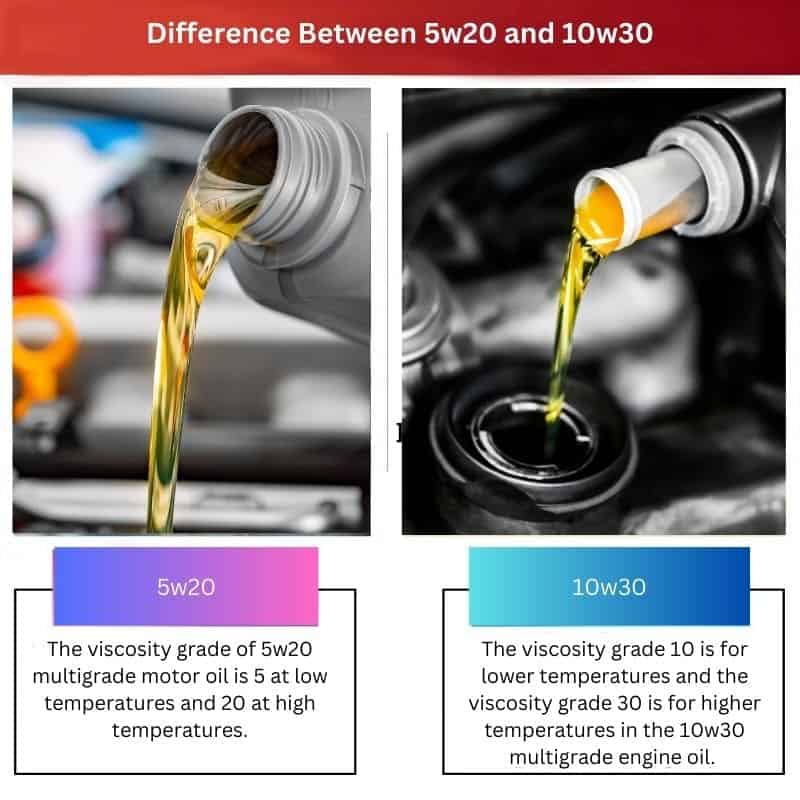Engine oil is a lubricant used in automobile engines, especially internal combustion engines. Engine oil, commonly referred to as engine oil or engine lubricating oil, is a liquid used to lubricate the engine.
Multigrade oils have two viscosity grades: one for viscosity at low temperatures (denoted with a “W” for winter) and another for viscosity at higher temperatures (denoted with “H” for summer). Multi-grade oils are 10w30 and 5w20.
Key Takeaways
- 5W20 and 10W30 refer to different grades of engine oil.
- 5W20 has better fuel efficiency and is recommended for newer engines, while 10W30 provides better protection at higher temperatures and is recommended for older engines.
- 5W20 has a lower viscosity than 10W30, meaning it is thinner and flows more easily at lower temperatures.
5w20 vs 10w30
The low w of 5W20 indicates that 5W oils will flow more quickly in cold conditions since they will remain thinner and easily circulate throughout the engine for greater start-up protection. In contrast, it is advised to use 10W30 in older engines because it offers better protection at higher temperatures.

5w20 is multi-viscosity engine oil that’s used in cars. It’s one of the Society of Automotive Engineers (SAE) Standard viscosity grades, used to keep the engine running at various temperatures.
The cold-temperature viscosity value is 5, while the high-temperature viscosity rating is 20. They’re thin enough to flow efficiently at low temperatures, so in cold conditions, the oil will thicken less and offer sufficient engine lubrication
10w30 is also a multi-grade engine oil primarily used in vehicles with heavy-load engines due to its ability to withstand high temperatures for an extended period without compromising engine performance.
Because older engines need heavier oil for optimal engine lubrication and engine lifespan, 10w30 is one of the most recommended oil grades for commercial vehicles with older engines.
Comparison Table
| Parameters of Comparison | 5w20 | 10w30 |
|---|---|---|
| Viscosity | Lower. | High. |
| Works | Within the temperature range -30 degrees to 35 degrees celsius. | Within the temperature range -18 degrees to 30 degrees celsius. |
| At Low Temperature | Thinner. | Thicker. |
| Provides | Cold weather starting. | Sealing Action. |
| Used By | Light duty petrol and diesel engines. | Heavy load-hauling engines. |
What is 5w20?
The viscosity grade of 5w20 multigrade motor oil is 5 at low temperatures and 20 at high temperatures. At low temperatures, it has a low viscosity grade, which implies the oil is thin.
Correspondingly, the oil thickens as the temperature rises. 5w20 engine oil meets API SN standards and, depending on the brand, has an ACEA grade. MB approval is also included in 5w20.
Mercedes-Benz approval refers to Mercedes-Benz standards that give an engine oil grade. The MB rating of 5w20 is also determined by the oil brand. In addition, VW approval (Volkswagen oil standards), Ford oil specifications, and Porsche oil specifications are also included in 5w20.
5w20 offers a lot of advantages and characteristics that aren’t seen in other oils. It creates a continuous coating of overall engine components, which reduces friction between moving parts.
They minimize engine wear and tear while keeping the engine cool during start/stop operations. They help keep the engine components from rusting. Engine oil, in general, extends the life of the engine.
They have excellent thermal stability, which means they retain their characteristics even when temperatures fluctuate dramatically. It is also intended to reduce oil consumption since a small quantity of engine oil is required to lubricate an engine.

What is 10w30?
The viscosity grade 10 is for lower temperatures, and the viscosity grade 30 is for higher temperatures in the 10w30 multigrade engine oil. At low temperatures, 10w30 oils have a viscosity of 10, while at high temperatures, they have a viscosity of 30.
At lower temperatures, it has a low viscosity grade, indicating that the oil is thin. At higher temperatures, the oil also thickens. API SN, ACEA grade, and viscosity grade are some of the qualities required for 10w30 oil.
The American Petroleum Institute created the API SN engine oil category to show oil that meets certain requirements. The engine must be capable of protecting the piston from deposits created by fuel combustion.
It must have superior sludge management, meaning it should not produce any unwanted gels or sludge at higher temperatures. Seal compatibility and post-processing compatibility are also required.
They keep the engine cool while reducing engine wear and tear during start/stop operation. They also help to prevent rusting of engine components. 10w30 engine oil, on the whole, extend the life of engines.
It is possible to have a smooth clutch and gear action. Consequently, it is possible to run the engine without making any noise. Even when the temperature varies much, it maintains its viscosity.

Main Differences Between 5w20 and 10w30
- The viscosity of 5w20 is lower compared to 10w30, whereas the viscosity of 10w30 is higher compared to 5w20.
- 5w20 works within the temperature range of -30 degrees to 35 degrees Celsius, whereas 10w30 works within the temperature range of -18 degrees to 30 degrees Celsius.
- 5w20 is thinner at lower temperatures, whereas 10w30 is thicker at lower temperatures.
- 5w20 is better for cold-weather starting, whereas 10w30 is better for sealing action.
- Light-duty petrol and diesel engines use 5w20, whereas large-weight carrying engines need 10w30.





